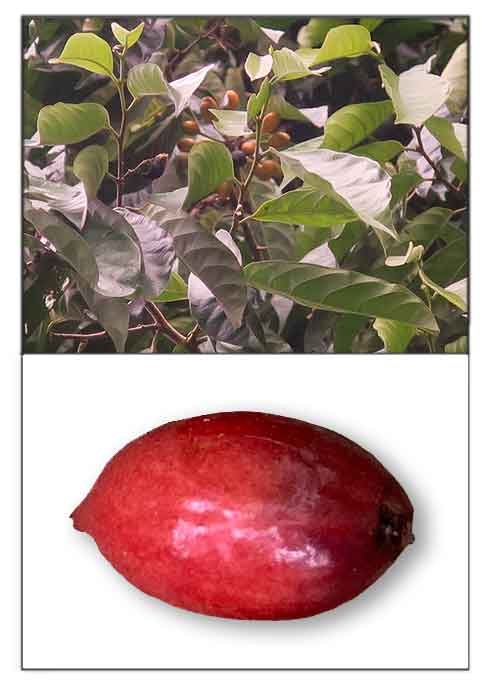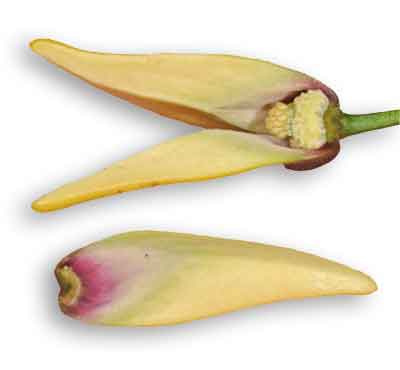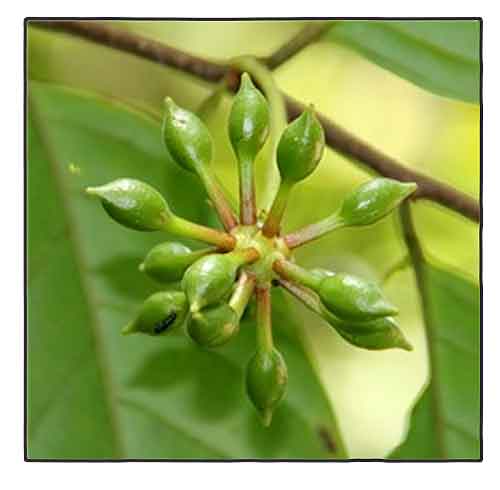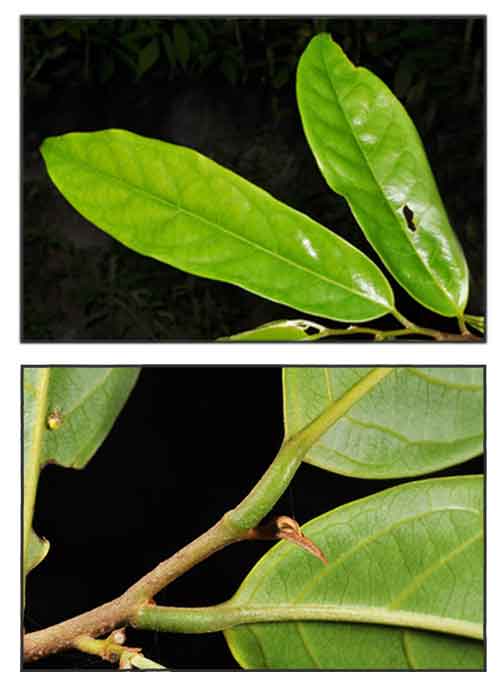 Gen info Gen info
• Phaeanthus ophthalmicus is a species of plant in the family Annonaceae and tribe Miliusease. It is found from Peninsular Malaysia to New Guinea. (7)
• As of January 2026, Plants of the World Online lists 9 species in the genus.
- Etymology: The specific epithet ophthalmicus derives from Latin, meaning "eyes", probably referring to one of its medicinal properties.
Botany
• Kalimatas is a small tree growing up to 15 meters in height. Leaves are ovate-lanceolate, 10 to 20 centimeters long, 3.5 to 6.5 centimeters wide, pointed at both ends, and borne upon 5-millimeter petioles. Flowers are solitary, or grow 3 to 4 together on the axils of the leaves, with 2- to 3-centimeter pedicels. Sepals are minute, triangular, and hairy. Petals are very unequal; the outer ones, oblong and 1.5 to 2 centimeters in length; the inner ones, ovate and smaller. Fruit are numerous, ovoid or ellipsoid-spiculate, yellowish when immature, reddish black when ripe, smooth, and borne in round clusters upon smooth stalks 2 to 3 centimeters long.
Distribution
-
Native to the Philippines. (6)
-
Widely distributed in the Philippines at low and medium altitudes.
- Also native to Borneo, Lesser Sunda Is., Malaya, Maluku, New Guinea, Sulawesi. (6)
 Constituents Constituents
- Yields two alkaloids: one is a tertiary, nonphenolic, crystalline base, occurring in the amount of 0.7% with the formula C34H38N2O6 or C35H40N2O6, given the name phaeanthine. The other alkaloid has the properties of a quarternary base.
- Structure of phaeanthine is similar to that of oxyaeanthine and of berbamine.
- Study yielded another tertiary alkaloid in the form of fine crystals, kalimatine.
- Study of crude extract afforded (+)-tetradrine (1) and (+)-limascusine (2) as major biologically active tetrahydrobisbenzylisoquinolinev alkaloidal constituents after purification. (see study below) (8)
Properties
- The quarternary solution and galenical preparations (tincture and fluid extract) have shown important pharmacodynamic effects of lowering blood pressure and relaxing smooth muscle. The fall in blood pressure may be partly due to depression of the heart. Sufficiently large doses also depress the intestine, tracheal muscles, and uterus.
- Studies have suggested antibacterial, anti-leukemic, COX-inhibitory, anti-obesity, antidiabetic, antituberculosis, antiproliferative properties.
Parts used
Bark, leaves, stems.
 Uses Uses
Folkloric
- In the Philippines, traditionally used to treat conjunctivitis, ulcers and wound infections.
-
After the outer portion of the bark has been removed, very thin pieces of plant scrapings are placed in a small amount of water. The mixture is macerated and filtered through a piece of cloth, and dropped into sore eyes with inflamed conjunctiva, daily until the conjunctivitis is cured.
- The Ayta people of Porac, Pampanga province mash fresh or dried leaf and stems, then burned and applied to the body as repellent against hematophagous insects. (5)
Others
- Wood: Bark is used for tying purposes. Wood used for light house construction.
Studies
• Phaenthine / Leaves: Study of chloroform-soluble fractions of leaves of P. ebracteolatus isolated fine needle-like crystals identified as phaenthine by spectroscopy. (2)
• Cyclic Tetrapyrrolic Photosensitisers / Decreased In Vitro Viability of Leukemic HL60 Cells / Leaves: The ethanolic extract of leaves reduced the in vitro viability of leukemic HL60 cells to <50% when exposed to 9.6 J/cm2 of broad spectrum light at concentration of 20 µg/mL. Study reports the main photosensitisers in plants are based on the cyclic tetrapyrrole structure. (4)
 • Antibacterial / COX-Inhibitory / Alkaloids: Study evaluated the antimicrobial ad COX inhibitory activities of extracts and tetrahydrobisbenzylisoquinoline alkaloids in vitro and in silico. The DCM-MeOH (dichlromethane-methanol) crude extract and alkaloids exhibited antibacterial activities against drug-resistant Enterococcus (VRE), Klebsiella pneumoniae + CRE and Pseudomonas aeruginosa + MBL. The crude extract afforded (+)-tetradrine (1) and (+)-limascusine (2) as major biologically active tetrahydrobisbenzylisoquinolinev alkaloidal constituents after purification. Both alkaloids 1 and 2 showed broad spectrum antibacterial activity with strong inhibition against Gram(-) MßL-Pseudomonas aeruginosa, Klebsiella pneumonia + CRE. Limacusin (2) showed selective inhibition against ovine • Antibacterial / COX-Inhibitory / Alkaloids: Study evaluated the antimicrobial ad COX inhibitory activities of extracts and tetrahydrobisbenzylisoquinoline alkaloids in vitro and in silico. The DCM-MeOH (dichlromethane-methanol) crude extract and alkaloids exhibited antibacterial activities against drug-resistant Enterococcus (VRE), Klebsiella pneumoniae + CRE and Pseudomonas aeruginosa + MBL. The crude extract afforded (+)-tetradrine (1) and (+)-limascusine (2) as major biologically active tetrahydrobisbenzylisoquinolinev alkaloidal constituents after purification. Both alkaloids 1 and 2 showed broad spectrum antibacterial activity with strong inhibition against Gram(-) MßL-Pseudomonas aeruginosa, Klebsiella pneumonia + CRE. Limacusin (2) showed selective inhibition against ovine
COX-2 in vitro. Molecular docking and dynamics simulation experiments showed alkaloid 2 with strong affinity in catalytic sites of Gram(-) bacterial en
zymes P. aeruginosa catalase and K. pneumonia KPC-2 carbapenemmase (enzymes involved in infectivity mechanisms), and ovine COX-2. Study suggests the alkaloids, especially 2, has potential for development of treatments for bacterial/inflammation-related infections. (8)
• Tetrahydrobisbenzylisoquinoline Alkaloids / Enzyme Inhibitory / Antidiabetic / Anti-Obesity: Study evaluated the inhibitory potential of P. ophthalmicus alkaloidal constituents tetrandrine (1) and limacusine (2) against enzymes implicated in type 2 diabetes and obesity such as α-glucosidase,
dipeptidyl peptidase-IV (DPP-IV) procine pancreatic lipase (PPL) and human monoacylglycerol lipase (MAGL). Both alkaloids showed stronger inhibition against α-glucosidase compared to control acarbose. Alkaloid 1 also exhibited better inhibitory activity against DPP-IV compared to control sitagliptin. Alkaloid 2 showed better in vitro and in silico inhibitory activity against PPL compared to orlistat. Both alkaloids showed moderate activity against MAGL. Results suggest potentials for the alkaloids for development of new-generation products against T2D and obesity. (9)
• Neuropharmacological Uses of Alkaloids: Extensive molecular docking studies on P. ophthalmicus identified 4MF3 (Kainate 1), 5O8F and 6HUK (GABAA), and 6G79 (Serotonin 1B) as potential neuroreceptor targets, which are involved with pain, migraine, stroke, epilepsy, and anxiety, among other neurological disorders. Also 50 or the 232 generated analogs of the alkaloids displayed better docking scores, novelty, and predicted drug-likeness. A corydaldine analog was considered a promising oral neuropharmacological agent after displaying consistent docking scores across all neuroreceptors, drug-likeness, and favorable pK profiles in silico. Follow-up studies are awaited. (10)
• Antituberculosis / Antiproliferative / Tetrahydrobisbensylisoquinoline (THBBI) Alkaloids: Study evaluated the antitubercular and antiproliferative activities of P. ophthalmicus extracts and THBBI alkaloids tetrandrine (1) and limacusine (2). Microplate Alamar Blue Assay (MABA) revealed anti-tubercular activities of extracts and fractions with MICs of 15.6 to <64 µg/mL. Limacusine exhibited inhibitory activity against Mycobacterium tuberculosis (MIC 42.6 µg/ml). Viability assay also showed antiproliferative activity for limacusin (2) against K-562. Both THBBI alkaloids exhibited cytotoxicity to HeLa cells. Molecular docking studies showed Limacusine (2) showed high binding propensities to mycobacterial enzymes ATP-dependent murE ligase and enoyl acyl carrier protein reductase. Results suggest THBBI alkaloids, especially limacusin (2), as promising natural products against TB and myeloid leukemia. (11)
Availability
Wild-crafted. |

![]()



 Gen info
Gen info Constituents
Constituents
 • Antibacterial / COX-Inhibitory / Alkaloids: Study evaluated the antimicrobial ad COX inhibitory activities of extracts and tetrahydrobisbenzylisoquinoline alkaloids in vitro and in silico. The DCM-MeOH (dichlromethane-methanol) crude extract and alkaloids exhibited antibacterial activities against drug-resistant Enterococcus (VRE), Klebsiella pneumoniae + CRE and Pseudomonas aeruginosa + MBL. The crude extract afforded (+)-tetradrine (1) and (+)-limascusine (2) as major biologically active tetrahydrobisbenzylisoquinolinev alkaloidal constituents after purification. Both alkaloids 1 and 2 showed broad spectrum antibacterial activity with strong inhibition against Gram(-) MßL-Pseudomonas aeruginosa, Klebsiella pneumonia + CRE. Limacusin (2) showed selective inhibition against ovine
• Antibacterial / COX-Inhibitory / Alkaloids: Study evaluated the antimicrobial ad COX inhibitory activities of extracts and tetrahydrobisbenzylisoquinoline alkaloids in vitro and in silico. The DCM-MeOH (dichlromethane-methanol) crude extract and alkaloids exhibited antibacterial activities against drug-resistant Enterococcus (VRE), Klebsiella pneumoniae + CRE and Pseudomonas aeruginosa + MBL. The crude extract afforded (+)-tetradrine (1) and (+)-limascusine (2) as major biologically active tetrahydrobisbenzylisoquinolinev alkaloidal constituents after purification. Both alkaloids 1 and 2 showed broad spectrum antibacterial activity with strong inhibition against Gram(-) MßL-Pseudomonas aeruginosa, Klebsiella pneumonia + CRE. Limacusin (2) showed selective inhibition against ovine 